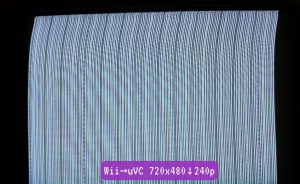Setup required: None
Cost and availability: Rarely found second-hand online, expensive
The Universal Video Converter (uVC) was actively supported by UltraCade Technologies between 2003-2005, and were intended for downscaling PC’s to a tri-sync arcade cabinet. They officially support the following resolutions: XGA (1024×768), SVGA (800×600) and VGA (640×480), and downscale to EGA (640×384, 24KHz) and CGA (640×240 15KHz ie 240p). The 640×480 input will likely be the more useful input resolution for console gaming, given the other two are PC resolutions.
The RGB and sync output voltage levels are >1.0vpp which should be suitable for an arcade chassis. However for standard definition CRT’s and most professional video monitors, the RGB levels should be attenuated to 0.7vpp. There are several methods to achieve this, including:
- In-line resistors on the RGB lines (75ohm reduced the RGB voltage to approximately 0.7vpp) and 470 on sync for consumer Scart TV’s
- An Extron RGB interface with a ‘video level’ potentiometer to reduce the RGB levels (a 470ohm resistor on sync is still recommended for consumer Scart TV’s)
- A circuit designed to interface arcade PCB’s to Scart, such as these Jamma to Scart Dongles which attenuate RGB and C-Sync to safe levels for Scart TV’s
The uVC will accept a 720x480 signal (480p), but the image is scaled horizontally, where retro-inspired games with horizontal scrolling will have noticeable shimmer. The uVC produced fsync ‘flagging’ which presented as a rightward curl at the top of the screen, though this was not present on an NEC Multi-Sync CRT monitor that was capable of receiving the higher voltage HV or C-sync without sync attenuation; therefore it will probably look fine on most arcade monitors.

The 240p output is achieved by blending 2 adjacent fields and is done with less than 2msec of lag (effectively zero!). The uVC lacks any picture adjustments, and an external primary image shifter may be required to offset the vertical line averaging for line-doubled content. 24KHz/384p output looks decently sharp, though most tri-sync monitors can display native VGA without scaling, which brings into question the usefulness of 24KHz output from a VGA source. XGA/1024×768 is however twice the vertical height of 384p, and is the superior resolution combination if the video source is sprite-heavy.

CRTEmudriver, GroovyMAME and Groovy_MiSTer may deem the Ultracade uVC redundant to downscale PC’s nowadays, but they have merit in downscaling consoles such as the XBOX 360 which can output VESA standard resolutions through VGA. Otherwise outside of these scenarios, there are more accessible and suitable downscalers that will get the job done.
Verdict: Seldom Reccomended
See the links below for further information:
https://www.emphatic.se/ultracade.html
https://www.retroblast.com/reviews/Ultacade_uVC-03212006-01.html
https://service.globalvr.com/downloads/ultracade/components/040-uvcmanu-uct_uvc_user_guide_v03b.pdf
